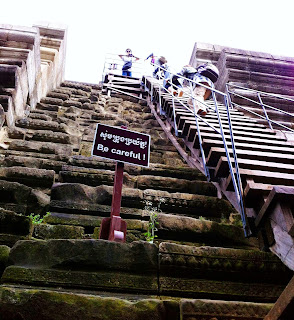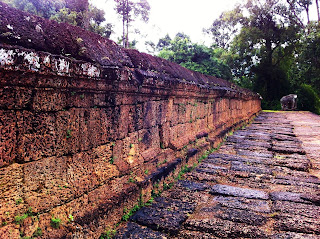ANGKOR THOM COMPLEX
The "Great City" - last capital of the Khmer Empire.
5 Entry Towers into Angkor Thom Complex
- The Draw: 108 stone figures (54 demons to the right; 54 gods on the left) flanking the causeway leading to each entry tower.
- Crowd Factor: South Gate - High (very, very crowded in the morning). North and Victory Gate - Low. Same stone figures and towers without the people.
- Accessibility: Easy.
- Time Spent: 5 minutes for photos, then drive through the gate.
- The Draw: Most famous Angkor Thom structure. Intricate temple in Bayon style of architecture with over 2000 iconic face carvings on 54 towers of the "Smile of Angkor", possibly the face of King Jayavarman VII meditating.
- Crowd Factor: High. Extremely crowded.
- Accessibility: Easy-Medium. Easy to walk around the outside of the temple; medium level of difficulty to walk through the temple with lots of uneven stones, stairs, and narrow walkways to navigate.
- Time Spent: 1.5 hours, but could easily spend more time.
- Built: 12th-13th century by King Jayavarman VII, dedicated to Buddha.
- Highlights: Enjoy the "Smile of Angkor" stone faces from many angles and levels; admire the architecture from afar by walking around the complex; ride an elephant around the complex.
- The Draw: Tallest location in Angkor Thom. Mound and tower symbolizing Mount Meru. Climb to the top terrace for a panoramic view of Angkor Thom.
- Crowd Factor: High.
- Accessibility: Difficult. Although they've built wooden stairs with handrails over the slippery stone steps, it is still a very steep climb and many, many steps to access to the top terrace.
- Time Spent: 1 hour.
- Built: 11th century by King Udayadityavarman II, dedicated to Hindu god Shiva.
- Highlights: View from the top.
- The Draw: Nice walk through the forest from Baphoun, back to the parking lot.
- Crowd Factor: Medium.
- Accessibility: Easy walk through marked trails from Baphoun, past the location where the palace would've been, past the Phimeanakas temple, and surround pools.
- Time Spent: 30 minutes.
- Built: 10th-11th century.
- The Draw: Statue of Hindu god Yama atop the mound called "Leper King" due to discoloration and moss, reminiscent of a person with leprosy. Also, King Yasuvarman I had leprosy. Now, only a replica. Original at National Museum in Phnom Penh.
- Crowd Factor: Medium.
- Accessibility: Easy. Few steps to statue. Raised wooden plank around the base to view all the bas-relief carvings.
- Time Spent: 15 minutes.
- Built: 12th century by King Jayavarman VII.
- Highlights: We enjoyed the multitude of bas-relief carvings of favorite Khmer characters surrounding the entire mound.
Preah Khan
- The Draw: Quieter temple, largely unrestored with similar trees and vegetation growing amongst ruins like Ta Prohm.
- Crowd Factor: Low.
- Accessibility: Medium. Flat temple design but lots of rubble to walk through. Layout is quite expansive.
- Time Spent: 1 hour.
- Built: Buddhist temple built in 12th century by King Jayavarman VII, dedicated to his father, Dharanindravarman. Built on the battle site where Jayavarman defeated the Chams (Muslims).
- Highlights: More trees growing over ruins but without the crowds hampering your view; a stupa in the middle of the complex that looks candlelit when viewed with light coming through the temple; photo with headless Buddha.
- The Draw: Buddhist temple in the middle of an artificial island surrounded by 4 pools.
- Crowd Factor: Low.
- Accessibility: Easy. Long wooden raised walkways above the swamp leads you to the temple. Short distance.
- Time Spent: 20 minutes.
- Built: 12th century by King Jayavarman VII, originally designed for medical purposes as a hospital with 4 healing pools representing Water, Earth, Fire, and Wind.
- Highlights: Beautiful walk along the wooden walkway; watch children swim and dive for snails collected for supper. They tuck the snails into their swimming trunks until they're out of the water!
- The Draw: Very similar in design to Preah Khan, but smaller. More quiet, largely unrestored, trees and vegetation growing amongst the ruins also.
- Crowd Factor: Low.
- Accessibility: Easy.
- Time Spent: 30 minutes.
- Built: 12th century by King Jayavarman VII dedicated to his father Dharanindravarman.
- The Draw: Sculptures of elephants and lion-dragons at this temple on an artificial island formerly surrounded by water.
- Crowd Factor: Low.
- Accessibility: Medium. Several large steps, but can walk easily around the tiers.
- Time Spent: 45 minutes.
- Built: 10th century by King Rajendravarman, dedicated to Hindu god Shiva.
- Highlights: Stone elephant statues are all slightly different and life-like.
- The Draw: One of the few temples of red brick construction.
- Crowd Factor: Low.
- Accessibility: Difficult. Lots of climbing uneven stone stairs to get to the top.
- Time Spent: 30 minutes.
- Built: 10th century by King Rajendravarman as a funerary temple.
- Highlights: View from the top tier; red brick construction; tufts of vegetation growing through the layers of brick atop the towers.
Our 2nd day (Angkor Thom and Grand Circuit) took about 7 hours total, same as the Day 1 going through most of the Small Circuit. One option that we didn't exercise was to drive another 30 minutes plus a 30 minute walk up to Phnom Bakheng temple to watch the sunset and get a 360 panoramic view of Tonle Sap Lake and Angkor Wat below.
Last but not least, a major highlight of our trip was the opportunity to meet photographer John McDermott - the Ansel Adams of Angkor.
Again, the beauty of social networking is that a friend of ours, following our Facebook page, told us that his cousin is a photographer in Siem Reap. Turns out, his cousin is a very famous photographer in Siem Reap! Here is a New York Times article from June 10th, 2007 by Matt Gross, Capturing Angkor Before Tourism Works Its Change, profiling John McDermott.
Thanks to our friend Joel, we got in touch with John McDermott and though his schedule is very busy with many business commitments, he invited us to a private reception he was hosting at his downtown gallery location so that we could meet him.
His photographs are very impressive. They have been feautured worldwide and part of the permanent collection at the National Museum in the capital city of Phnom Penh. We thought they were the perfect memento of our trip to Cambodia, and an early 10 year anniversary gift to ourselves.






























































